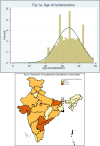Patterns of hysterectomy in India: a national and state-level analysis of the Fourth National Family Health Survey (2015-2016)
- PMID: 31309706
- PMCID: PMC6772015
- DOI: 10.1111/1471-0528.15858
Patterns of hysterectomy in India: a national and state-level analysis of the Fourth National Family Health Survey (2015-2016)
Erratum in
-
Corrigendum.BJOG. 2020 Oct;127(11):e122. doi: 10.1111/1471-0528.16410. BJOG. 2020. PMID: 32939970 Free PMC article. No abstract available.
Abstract
Objective: The National Family Health Survey-4 in India provided the first nationally representative estimates of hysterectomy among women aged 15-49. This paper aims to examine the national and state-level age-specific prevalence of hysterectomy, individual and household level factors associated with the procedure, and state-level indicators that may explain variation across states.
Design: Cross-sectional, nationally representative household survey.
Setting: National Family Health Survey was conducted across all Indian states and union territories between 2015 and 2016.
Population: The survey covered 699 686 women between the ages of 15 and 49 years.
Methods: Descriptive analyses and multivariate logistic regression.
Main outcome measures: Women who reported ever having a hysterectomy and age at hysterectomy.
Results: Age-specific prevalence of hysterectomy was 0.36% (0.33,0.39) among women aged 15-29; 3.59% (3.45,3.74) among women aged 30-39; and 9.20% (8.94,9.46) among women 40-49 years. There was considerable variation in prevalence by state. Four states reported age-specific prevalence similar to high-income settings. Approximately two-thirds of hysterectomies were conducted in private facilities, with similar patterns across age groups. At the national level, higher age and parity (at least two children); not having had formal schooling; rural residence (adjusted odds ratio [AOR] 1.36; 95% CI 1.27,1.45; P < 0.01) and higher wealth status were associated with higher odds of hysterectomy. Previously sterilised women had lower odds (AOR 0.64; 95% CI 0.61,0,68; P < 0.01) of reporting hysterectomy. Exploratory analyses suggest state-level factors associated with prevalence of hysterectomy include caesarean section, female illiteracy, and women's employment.
Conclusions: Hysterectomy patterns among women aged 15-49 in India indicate the critical need to ensure treatment options for gynaecological morbidity and to address hysterectomy among young women in particular.
Funding: This study was part of the RASTA initiative of the Population Council's India country office under the Evidence Project supported by USAID.
Tweetable abstract: Hysterectomy patterns in India highlight the need for alternatives to treat gynaecological morbidity among younger women.
Keywords: India; epidemiology; gynaecology; hysterectomy; menstrual bleeding.
© 2019 The Authors BJOG: An International Journal of Obstetrics and Gynaecology published by John Wiley & Sons Ltd on behalf of Royal College of Obstetricians and Gynaecologists.
Figures
Comment in
-
Priorities in health care for women in India.BJOG. 2019 Aug;126 Suppl 4:5-6. doi: 10.1111/1471-0528.15859. BJOG. 2019. PMID: 31475789 No abstract available.
Similar articles
-
Services for women's sexual and reproductive health in India: an analysis of treatment-seeking for symptoms of reproductive tract infections in a nationally representative survey.BMC Womens Health. 2020 Jul 28;20(1):156. doi: 10.1186/s12905-020-01024-3. BMC Womens Health. 2020. PMID: 32723377 Free PMC article.
-
Prevalence, sociodemographic determinants and self-reported reasons for hysterectomy in India.Reprod Health. 2019 Aug 2;16(1):118. doi: 10.1186/s12978-019-0780-z. Reprod Health. 2019. PMID: 31375139 Free PMC article.
-
Prevalence, socio-demographic determinants, and self-reported reasons for hysterectomy and choice of hospitalization in India.BMC Womens Health. 2022 Dec 12;22(1):514. doi: 10.1186/s12905-022-02072-7. BMC Womens Health. 2022. PMID: 36503443 Free PMC article.
-
Hysterectomy in a Danish cohort. Prevalence, incidence and socio-demographic characteristics.Acta Obstet Gynecol Scand. 1996 Mar;75(3):274-80. doi: 10.3109/00016349609047101. Acta Obstet Gynecol Scand. 1996. PMID: 8607343 Review.
-
Unnecessary Hysterectomies Among Premenopausal Women in Developed and Developing Countries: A Critical Review of Steps Taken to Improve Women's Health.Cureus. 2023 Dec 5;15(12):e49943. doi: 10.7759/cureus.49943. eCollection 2023 Dec. Cureus. 2023. PMID: 38179386 Free PMC article. Review.
Cited by
-
Corrigendum.BJOG. 2020 Oct;127(11):e122. doi: 10.1111/1471-0528.16410. BJOG. 2020. PMID: 32939970 Free PMC article. No abstract available.
-
Comparative Analysis of Total Laparoscopic Hysterectomy Versus Non-descent Vaginal Hysterectomy for Benign Uterine Pathologies in Women: A Systematic Review.Cureus. 2024 Jun 21;16(6):e62846. doi: 10.7759/cureus.62846. eCollection 2024 Jun. Cureus. 2024. PMID: 39036204 Free PMC article. Review.
-
Hysterectomy and women's health in India: evidence from a nationally representative, cross-sectional survey of older women.Womens Midlife Health. 2023 Jan 6;9(1):1. doi: 10.1186/s40695-022-00084-9. Womens Midlife Health. 2023. PMID: 36609516 Free PMC article.
-
Comparison of Bleeding Pattern and Quality of Life Before and After the Insertion of a Levonorgestrel Intrauterine System for Heavy Menstrual Bleeding: A Seven-Year Review.Cureus. 2023 Mar 14;15(3):e36142. doi: 10.7759/cureus.36142. eCollection 2023 Mar. Cureus. 2023. PMID: 37065377 Free PMC article.
-
Rising premature menopause and variations by education level in India.Sci Rep. 2024 Aug 6;14(1):18238. doi: 10.1038/s41598-024-67730-2. Sci Rep. 2024. PMID: 39107408 Free PMC article.
References
-
- Ong S, Codd M, Coughlan M, O'Herlihy C. Prevalence of hysterectomy in Ireland. Int J Gynaecol Obstet 2000;69:243–7. - PubMed
-
- Spilsbury K, Semmens J, Hammond I, Bolck A. Persistent high rates of hysterectomy in Western Australia: a population‐based study of 83 000 procedures over 23 years. BJOG 2006;113:804–9. - PubMed
-
- Redburn J, Murphy M. Hysterectomy prevalence and adjusted cervical and uterine cancer rates in England and Wales. BJOG 2001;108:388–95. - PubMed
-
- Stang A, Merrill RM, Kuss O. Prevalence‐corrected hysterectomy rates by age and indication in Germany 2005–2006. Arch Gynecol Obstet 2012;286:1193–200. - PubMed
MeSH terms
Grants and funding
LinkOut - more resources
Full Text Sources
Medical


